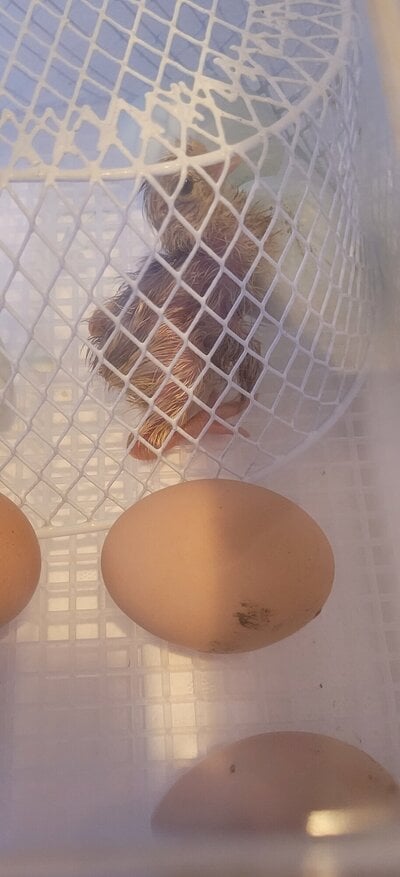These chicks are all from an orpington (buff+lavender) roo over cream legbar hens. In theory they should be sex linked... what are the 3 black ones then versus the blonde chipmunk that just hatched? Thanks in advance!
Navigation
Install the app
How to install the app on iOS
Follow along with the video below to see how to install our site as a web app on your home screen.
Note: This feature may not be available in some browsers.
More options
You are using an out of date browser. It may not display this or other websites correctly.
You should upgrade or use an alternative browser.
You should upgrade or use an alternative browser.
Orpington cross sex links?
- Thread starter ItsONuh
- Start date
Pics
More options
Who Replied?All the birds with headspots are definitely cockerels  The barring gene is located on the Z chromosome and females are ZW and males ZZ. Females receive a Z only from their father. Males receive a Z from each parent. This is why barring is only passed to cockerels
The barring gene is located on the Z chromosome and females are ZW and males ZZ. Females receive a Z only from their father. Males receive a Z from each parent. This is why barring is only passed to cockerels  The other chick should theoretically be a pullet if she has no headspot which indicates barring
The other chick should theoretically be a pullet if she has no headspot which indicates barring
 The other chick should theoretically be a pullet if she has no headspot which indicates barring
The other chick should theoretically be a pullet if she has no headspot which indicates barring- Thread starter
- #3
I guess I'm just confused because I wasn't expecting black chicks from this mix but maybe that's part of the barring? Would it then really be as simple as "chipmunk chicks are pullets & black barred are cockerels"? Couldn't possibly be that easy..All the birds with headspots are definitely cockerelsThe barring gene is located on the Z chromosome and females are ZW and males ZZ. Females receive a Z only from their father. Males receive a Z from each parent. This is why barring is only passed to cockerels
The other chick should theoretically be a pullet if she has no headspot which indicates barring
All the birds with headspots are definitely cockerelsThe barring gene is located on the Z chromosome and females are ZW and males ZZ. Females receive a Z only from their father. Males receive a Z from each parent. This is why barring is only passed to cockerels
The other chick should theoretically be a pullet if she has no headspot which indicates barring

I guess I'm just confused because I wasn't expecting black chicks from this mix but maybe that's part of the barring?
The black is because they are split to lavender.
Lavender is a modifier of black.

- Thread starter
- #6
Thanks. So to further solidify, with this mix the ones that come out black- the females would be solid black with no head spot. Chipmunk females will have a dark V on the heads while males have lighter heads. I think I'm understanding this better nowThe black is because they are split to lavender.
Lavender is a modifier of black.
Thanks. So to further solidify, with this mix the ones that come out black- the females would be solid black with no head spot. Chipmunk females will have a dark V on the heads while males have lighter heads. I think I'm understanding this better now
I don't understand the sexing of chipmunk chicks myself.

But the headspot means barred and any non-barred rooster X barred hens produces barred sexlinks with males barred and females not.

KeepClucking
In the Brooder
- Apr 26, 2022
- 21
- 27
- 46
Sorry to jump on this thread but it confuses me too. These lighter ones are from Whiting True Green hen X Lavender Orpington roo. In the past I’ve only hatched out darker chicks with red heads, so these took me off guard. Could they be sexed by these markings too. Thank you for any responses.
Attachments
New posts New threads Active threads
-
Latest threads
-
-
-
Feamle Quail feathers turning black
- Started by Deanna-Leigh
- Replies: 0
-
-
-
-
Threads with more replies in the last 15 days
-
-
Question of the Day - Thursday, August 14th, 2025
- Started by casportpony
- Replies: 69
-
Still no idea what’s going on with my hens comb and growing black spots
- Started by Ohsrsly
- Replies: 63
-
Ended BYC Poultry Caption Contest 08-08-25 Pic by Molpet
- Started by TwoCrows
- Replies: 62
-
-
×







